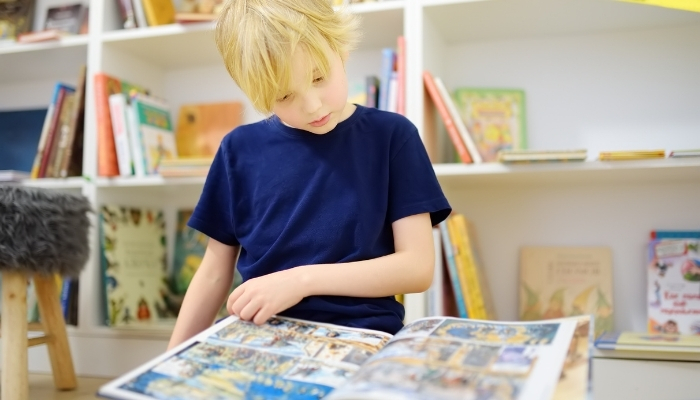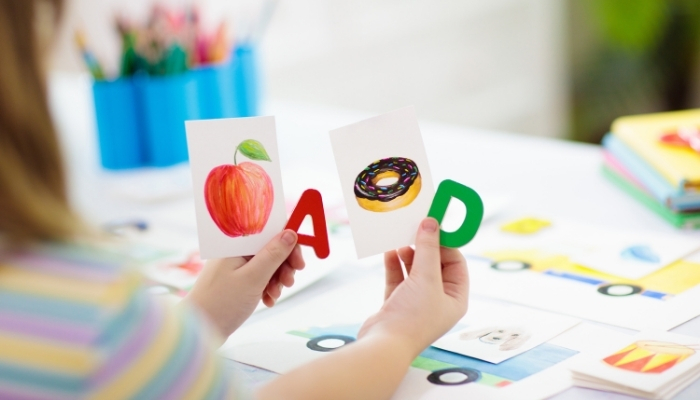Many parents notice that their children can read fluently but still struggle to explain what a story means. Others see their child losing focus or forgetting details soon after finishing a passage. These are common signs that a child might not be forming strong mental connections while reading.
That’s where the imagery strategy comes in, a simple way to help children connect words with meaning through mental pictures. When children learn to create images in their minds as they read, every word starts to feel alive. This not only strengthens comprehension but also builds confidence and curiosity toward reading and writing.
This article explains what the imagery strategy is, why it matters, and how parents can apply it at home to support their child’s literacy growth.
Key Takeaways
-
Imagery strategy turns reading into an experience. Children learn to connect words with sights, sounds, and emotions, making stories come alive.
-
Visualization boosts comprehension and memory. Forming mental pictures helps kids follow storylines, recall details, and understand meaning deeply.
-
Parents can strengthen imagery at home. Simple habits like pausing during read-alouds, asking sensory questions, and linking stories to real life build strong mental imagery.
-
Imagination improves both reading and writing. When children describe what they picture, their vocabulary, expression, and storytelling skills grow naturally.
-
FunFox Readers Club brings imagery to life. Through small, interactive classes and expert guidance, children build confidence and see every story unfold in their minds.
What Is the Imagery Strategy?

The imagery strategy encourages children to form mental pictures of what they read or hear. It helps them connect words with sights, sounds, and emotions, turning reading into an experience rather than a task.
For example, when children read The 78-Storey Treehouse by Andy Griffiths, they can picture the giant tree filled with wild inventions, car washes, and secret rooms. Each page sparks new images that make the story memorable and full of life.
When children practice this skill regularly, they begin to connect language with emotion and meaning, turning reading from word recognition into a rich, sensory experience.
Why Imagery Matters for Early Literacy?
Children who practice imagery regularly can remember stories more vividly and explain them with greater detail, when reading, writing, or speaking. Creating mental pictures while reading helps children connect words with meaning, remember key details, and stay engaged throughout a story.
-
Improves Comprehension
When children form clear mental pictures, they connect words with meaning, follow storylines naturally, and understand the author’s intent beyond surface details.
-
Strengthens Retention
Mental imagery helps information stick. Linking words to pictures makes it easier for children to recall story elements long after reading.
-
Expands Vocabulary and Expression
Describing what they picture encourages children to use richer language, specific words, sensory details, and creative phrasing that strengthen both reading and writing.
-
Builds Writing Flow and Confidence
Imagery supports writing by helping children organize their thoughts into clear, descriptive sentences. They learn to express emotions and actions with ease and fluency.
-
Keeps Reading Engaging
Visualization turns reading into a multisensory experience. It captures attention, fuels imagination, and keeps children eager to read more.
When children practice imagery consistently, they move from reading words to connecting with ideas. This shift builds the foundation for confident, expressive readers and writers.
Want to learn more ways to strengthen your child’s understanding while reading? Discover our guide on Effective Reading Comprehension Strategies for Kindergarten Students.
How Parents Can Spot When Imagery Skills Need Strengthening
Parents often notice small patterns in their child’s reading that can be confusing or concerning. These signs are common and usually mean your child hasn’t yet learned to build clear mental images while reading. Once they develop this skill, comprehension and confidence grow naturally.

-
Reads Fluently but Misses the Meaning
Some children read smoothly and quickly but can’t explain what the story was about. This happens when reading becomes mechanical; their eyes move across the words, but their mind isn’t forming clear pictures of what’s happening.
You can support them by slowing reading time down and pausing to talk about what they “see” in their mind. Asking gentle questions about the story helps words turn into understanding.
-
Struggles to Retell or Summarize
When a child finishes a story and can’t remember key details, it’s often because the information didn’t have strong visual links. Mental images act as anchors for memory; without them, the story fades quickly.
Encourage your child to describe what stood out to them, such as where the story took place or how the characters looked and felt. These conversations make comprehension more concrete.
-
Loses Focus Midway
If your child loses attention halfway through a book, it may be because the story feels flat or disconnected. Without a visual sense of what’s happening, the text can seem like a stream of unrelated words.
Turning reading into an interactive learning activity, using voices, gestures, or quick pauses to discuss details, helps keep focus steady and engagement high.
-
Shows Frustration or Avoids Reading
Children sometimes get discouraged when they can read the words but can’t make sense of the story. This frustration can show up as avoidance or negative self-talk.
Reassure your child that this is a normal part of learning and that their brain simply needs more practice linking words to meaning. Positive reinforcement and small, consistent steps can rebuild confidence.
Helping children strengthen imagery skills brings clarity, curiosity, and joy back to reading. Once they can picture the stories they read, they begin to connect deeply with the language, and that’s when true literacy growth begins.
5 Simple Ways to Strengthen Imagery Skills at Home
Children learn to form mental images when reading becomes interactive and reflective. The goal is to help your child slow down, think about what they’re reading, and connect stories to real-life experiences.

The following methods work well for parents who want to make reading time both meaningful and enjoyable.
1. Read Aloud and Talk About the Story
Reading together is one of the most great ways to strengthen imagery. Pause every few sentences and ask gentle questions that invite your child to think visually.
-
Ask, “What do you think this place looks like?” or “Who’s there right now?”
-
Discuss what your child notices about colors, shapes, or movement in the story.
-
Share your own mental image to model how visualization works.
When you talk about the story, your child starts linking words to pictures, sounds, and feelings. This helps them remember details and understand the story beyond the surface level.
Choose books rich in description and action, such as Lulu Bell and the Birthday Unicorn by Belinda Murrell. These stories naturally invite children to form lively mental pictures as they read.
2. Connect Reading to Real-Life Experiences
Children understand best when they can relate stories to what they already know. Making personal connections turns abstract ideas into something real.
-
If a story mentions rain, remind your child of a day when you both carried umbrellas or jumped through puddles.
-
Compare characters’ feelings or situations to experiences your child has had.
-
Encourage your child to talk about how the story reminds them of something in their life.
These real-life links make stories feel familiar and memorable. They also show your child that reading connects to their world, not just the page.
3. Encourage Drawing and Descriptive Play
After finishing a story, ask your child to draw their favorite scene or act it out using toys or props. Turning words into pictures helps them visualize and express meaning.
-
Ask open questions such as, “Why did you choose this part?” or “What do you think happened right after this scene?”
-
Let your child explain their drawing to build descriptive language and sequencing skills.
-
Praise specific details (“I like how you added the clouds!”) to reinforce observation.
These activities help children organize their thoughts and speak about stories with confidence.
4. Ask Sensory and Emotional Questions
Prompt your child to think about how things look, sound, feel, or even smell in the story. Sensory questions bring reading to life.
-
“Was the forest quiet or noisy?”
-
“Do you think the character felt nervous or excited?”
-
“If you were in this scene, what would you notice first?”
These conversations build empathy and teach your child to connect emotionally with characters and settings.
5. Make Reading a Shared Experience
Set aside a few minutes each day for calm, shared reading time. Treat reading as a peaceful, rewarding moment rather than a task.
-
Choose a cozy spot and remove distractions.
-
Take turns reading pages or sentences.
-
End with a short chat about your favorite part of the story.
When parents show curiosity and patience, children mirror that attitude. Over time, your child begins to read with greater focus, stronger imagery, and a deeper appreciation for stories.
Turning Words into “Mind Movies”: How Families Can Practice Imagery Together
When children learn to make “mind movies” from what they read, stories come alive, characters, settings, and emotions all unfold in their imagination. This section shows how families can practice imagery in small, meaningful steps that deepen reading naturally.

1. Start with the Picture Before the Word
Choose a page with illustrations or descriptive language. Ask your child:
-
“Look at this scene, what do you think is happening just beyond the frame?”
-
“If this picture wasn’t here, what would you imagine is behind that tree/behind the door?”
This turns the illustration into a springboard, encouraging children to enrich the visuals in their minds beyond what’s on the page.
2. Read, Pause, & Share Your Images
As you read together:
-
Pause at rich descriptive passages.
-
Share what image you formed, and point out which words led you there (“I saw the moonlight dancing on the river, because of the phrase ‘silver shimmer’”).
-
Invite your child to share theirs.
This modeling shows them the “image thinking” process. Over time, they internalize the habit of asking, “What did I see in my mind just now?”
3. Re-play the Story from New Perspectives
After reading:
-
Ask your child to “rewind” a scene in their mind and imagine it from another character’s view.
-
Invite them to think about what smells, sounds, or textures might be in that scene (beyond just what was described).
This deepens their imagination and helps them consider sensory details that often remain “silent” in stories.
4. Illustrate Only What’s in the Imagination
Rather than illustrating exactly what’s on the page, encourage them to draw based on what they saw in their mind:
-
Ask, “Which detail stuck with you the most?”
-
Let them interpret it freely, not to match the book art, but their internal picture.
When a child draws from memory, they re-engage with the narrative, and their brain rehearses connections between words and imagery.
Want to extend imagery learning into writing? Explore our guide on Sensory Adventures: Engaging Five Senses Writing Activities for Kids to help your child bring words to life through every sense.
How FunFox Uses the Imagery Strategy to Build Confident Readers
FunFox turns reading into a vivid, engaging experience. By using the imagery strategy, our teachers help children picture what they read, strengthen comprehension, and build a genuine love for stories.

FunFox’s structured approach provides your child with focused, high-quality reading instruction that supports literacy development and imagination.
Here’s specifically how our program brings the imagery strategy to life for your child:
-
Expert-guided teaching: Our teachers are trained in the FunFox Way and understand how to nurture visual thinking through interactive reading sessions. They use proven methods to help children connect words with images and emotions for stronger comprehension.
-
Interactive and sensory-based learning: Every lesson includes reading games, picture-based prompts, and discussion activities that make imagery practice natural and fun. Students learn to describe what they see, hear, and feel as they read.
-
Small group sessions: Each class has only 3–6 students, allowing teachers to give personalized feedback while encouraging peer sharing. Children benefit from hearing how others imagine the same scene in different ways.
-
Weekly online lessons: Students join one-hour live Zoom sessions from anywhere in the world. Each session is recorded, giving families the option to revisit lessons anytime.
-
Ongoing feedback and home connection: Our teachers provide process-based feedback each week and share practical tips so parents can reinforce imagery and comprehension at home.
-
Engaging resources and materials: Children gain access to our digital learning portal, featuring interactive worksheets, reading passages, and creative literacy games, all designed to make the imagery strategy part of every story.
FunFox Readers Club gives every child the confidence to approach reading with curiosity and imagination. With expert teachers, small classes, and engaging lessons, your child won’t just read words; they’ll see the story come to life.
Conclusion
The imagery strategy helps children turn reading into an active, imaginative experience. When words spark pictures in a child’s mind, comprehension deepens, confidence grows, and stories feel alive.
Parents often describe the change as subtle but powerful; their child remembers more, talks about what they picture, and shows genuine curiosity about books. With steady guidance and engaging practice, imagery becomes a lifelong reading habit.
FunFox Readers Club is built on this belief. We help children:
-
Develop vivid reading comprehension through guided imagery and discussion.
-
Strengthen writing and vocabulary by describing what they picture in clear, expressive language.
-
Build focus and confidence in small, supportive groups.
-
Enjoy reading again through interactive lessons designed around curiosity and imagination.
-
Receive individual guidance from expert teachers who understand early literacy development.
Your child’s imagination is the key to lifelong learning. Support it with the FunFox Readers Club, where every story becomes an adventure, every word sparks an image, and every lesson builds a confident, capable reader.
FAQs About Imagery Strategy
1. What if my child can’t form pictures in their mind?
Some children experience weak mental imagery, known as aphantasia. You can adapt the imagery strategy by focusing on sounds, textures, or actions instead. Sensory variety builds comprehension even without strong visuals.
2. Does the imagery strategy help with nonfiction texts?
Yes. Visualization supports subjects like science and history by helping children “see” how processes work, such as imagining how rain forms or how ancient cities looked.
3. Can limited life experience affect a child’s mental images?
It can. If your child hasn’t experienced something described in a book, use photos or short videos before reading. Shared background knowledge strengthens imagery and understanding.
4. How can I tell if the imagery strategy is working?
Look for richer descriptions in your child’s speech or writing. They’ll begin using sensory words, colors, sounds, and emotions, and remember stories more clearly.
5. Should imagery be taught before or after reading fluency develops?
Start introducing it early, but focus on listening and discussion at first. Once decoding feels natural, the imagery strategy becomes a powerful bridge to comprehension.















